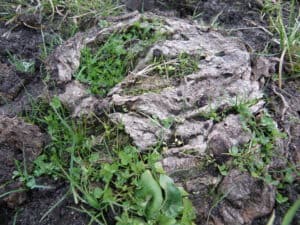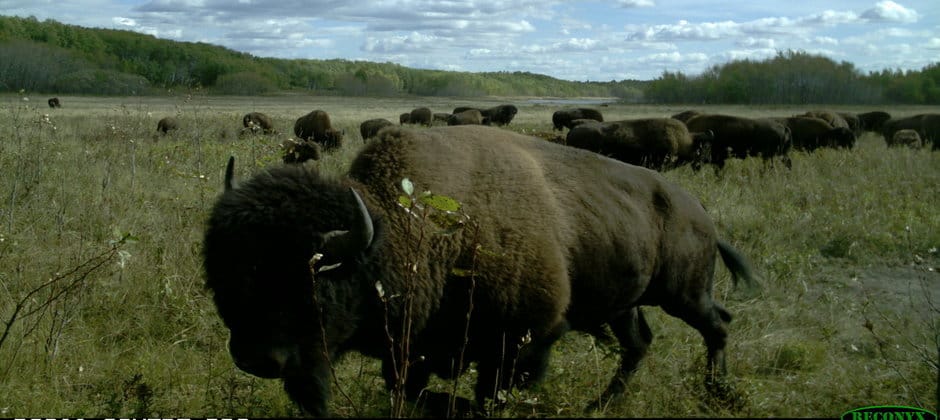Share this article
Wandering bison spread invasive plants in Canadian park
Marie Sigaud was studying bison behavior in Prince Albert National Park in Saskatchewan when she observed some strange behavior.
While the bison (Bison bison bison) spent their days in the meadows of the park, they were habitually crossing a shallow river bordering the park and wandering onto agricultural land for midnight snacks.
“Somehow they learned that they can cross this river and have access to high quality, digestible food made for cattle,” said Sigaud, a postdoctoral fellow at the University of Kyoto in Japan and the lead author of a study published recently in Animal Conservation.

Bison on Agricultural land. © Marie Sigaud
That has created a problem back in the park. Sigaud, who conducted the work as part of her doctorate work at Laval University in Québec, and her co-authors found that by raiding agricultural land, bison are bringing exotic plants into native ecosystems when they return. The discovery reveals a potential conflict between conserving a dwindling bison population and attempting to restore native ecosystems in the park by removing invasive and seeding native plants.
To conduct the study, the researchers observed the types of plants bison were eating outside versus inside the park.
They found that in the park, bison were mainly eating native plants. But on the agricultural land, they were eating clovers and other types of cultivated plants like Timothy-grass and alfalfa.
After collecting and analyzing 283 bison fecal samples, they found that most of the seeds in these samples were from the exotic species.
Sigaud and her colleagues also mapped the trails bison made through the park and looked at plant growth along these trails and around bison wallows — depressions the animals create by rolling around on the ground. In the course of this activity, bison can disperse seeds stuck in their fur and hooves or in their scat.

Exotic clovers growing out of a bison patty in the national park. © Marie Sigaud
The team found exotic plants around bison wallows and along bison trails.
Grasslands made up of native fescue grass species are declining in many parts of North America with invasive plant species being a main threat. Efforts in Prince Albert National Park are underway to remove these invasive plants and reseed areas with native fescue grasses, but Sigaud said the bison may be unwittingly sabotaging these efforts.
“Bison are there, they are going out on a daily basis, and they are bringing in a lot of exotic species,” she said.
Since bison can retain food in their bodies for up to 78 hours before passing it in their feces, the animals can spread exotic seeds quite far into the park.
For Sigaud, the problem is a difficult one because of the declining state of bison, which are vulnerable to legal but unregulated hunting which is unsustainable, according to a previous study, in the area as soon as they leave the boundaries of the park. Prince Albert National Park sits roughly in the middle of Saskatchewan and doesn’t draw in many tourists, despite having one of the two remaining free-ranging bison populations in Canada.
The other population is in Alberta’s Banff National Park. But just as Parks Canada is in the process of reintroducing these animals to the better known and iconic Banff, the population in Prince Albert has plummeted from about 500 animals in 2005 to roughly 80 remaining adults, Sigaud said.
“You have the same species in both national parks, managed by the same federal agency, and efforts towards conservation is very different,” she said.

Some bison wallows like this one were surrounded by exotic plants. © Marie Sigaud
This isn’t the only place that bison have caused problems to native vegetation. Bison in Yellowstone National Park have recovered to such numbers that they are trampling native vegetation.
A potential solution in Prince Albert could be to block the bison from accessing the native grasslands so they don’t sabotage restoration processes there. The trouble is, Sigaud said, “you might also be blocking other ungulates as well.”
Another solution would be to fence them into the park so they can’t access the agricultural lands where they eat exotic plants.
Whatever is done, Sigaud said, the conservation regimes focusing on plant restoration and bison need to come to an understanding about this problem.
“Otherwise you don’t know what you are fighting against,” she said.
Header Image: Bison in Prince Albert National Park. © Marie Sigaud, Université Laval








